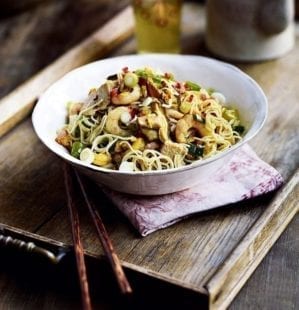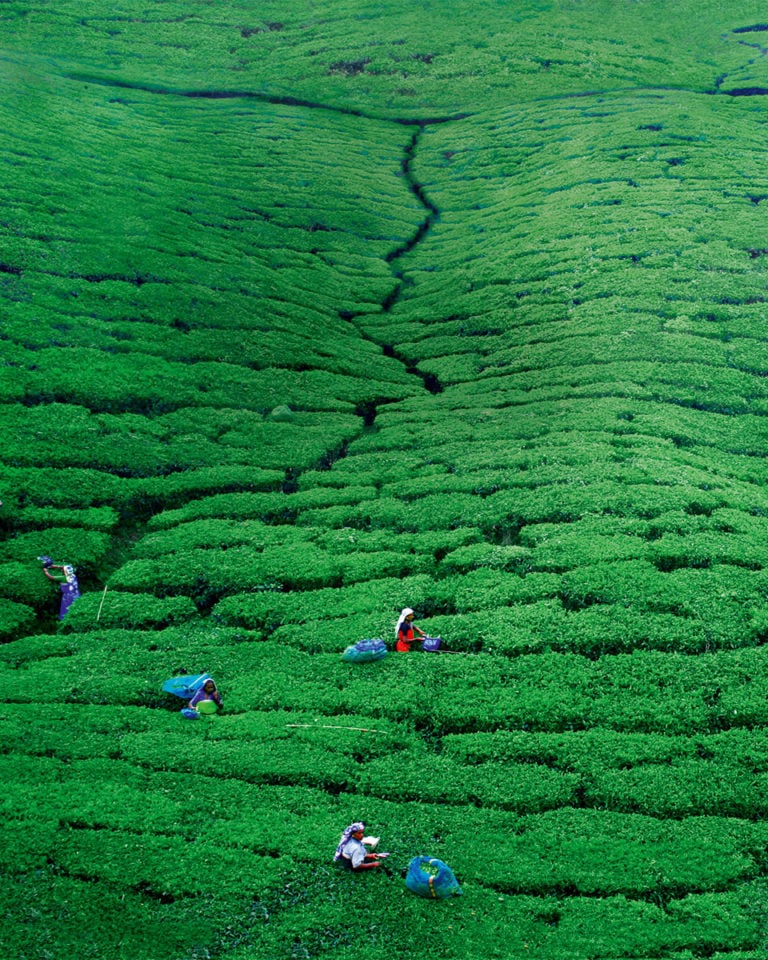Where to eat in Singapore
There are international superchefs galore in the food-obsessed city-state,
but the street food, which has been awarded Michelin stars, is some of the best in the world – even if it’s not actually on the street… Jenny Linford trawls the shopping centres to track down the hottest Singaporean dishes in town. Check out her foodie postcard to find the best places to eat in Singapore.

I love night-time in the Tropics. The air is soft, warm and humid, and once the sun goes down, everyone’s thoughts turn to the same thing: dinner. Being of Singaporean heritage, I have fond memories of my years living here as a child: visiting night markets, eating grilled satay or the infamously pungent durian fruit by the harbour. My time spent in this prosperous Southeast Asian city-state shaped my love of food and I’m sure led to me becoming a food writer.
I returned for a family visit, hungry to reacquaint myself with much-loved childhood dishes. “Food is the national pastime. No, it’s an obsession!” laughed one of my Singaporean cousins as we gathered round the dinner table. As you’d expect from a country with four national languages (Mandarin, Malaysian, Tamil and English), Singapore’s food scene is gloriously diverse, reflecting its history as a major port and the communities who settled here. Hainanese chicken rice from China and Malaysian satay are both popular Singaporean dishes.
The city’s restaurant scene is as international as London’s, showcasing chefs and cuisines from around the globe. For me though, a trip to Singapore is about enjoying the local food – and that means heading to the city’s ‘hawker food’ centres.
Proper street food – at a great price
Hawker food is the term given to the grub sold by formerly itinerant street vendors. This Singapore-style street food is served up in clean, well regulated markets (hawker centres). It’s excellent value – and often amazingly high quality. The first Michelin Guide to Singapore, published in 2016, recognised the quality of hawker food by awarding Michelin stars to two stalls: Hill Street Tai Hwa Pork Noodle in Crawford Lane and Hong Kong Soya Sauce Chicken Rice & Noodle in the Chinatown Complex. ‘What’s Your Favourite Hawker?’ is a popular national sport among the food-obsessed populace, with much time spent in happy, heated discussion championing the merits of one stall’s way with char kway teow (fried rice noodles) or the lightness of another’s roti prata (layered flat bread).
Every shopping centre or grand hotel has a basement food court but it’s worth visiting the bigger, famous hawker centres such as Newton Food Centre (Newton Circus) and Maxwell Road Centre (on the corner of Maxwell Road and South Bridge Road) for the bustle and dazzling choice of dishes. On a weekday lunchtime visit to Maxwell Road you’ll find queues of neatly dressed office workers waiting patiently for freshly made dishes such as fried oyster omelette, fish bee hoon (fish and noodle soup) or congee (rice porridge with a variety of savoury toppings). No pre-cut sandwiches here!
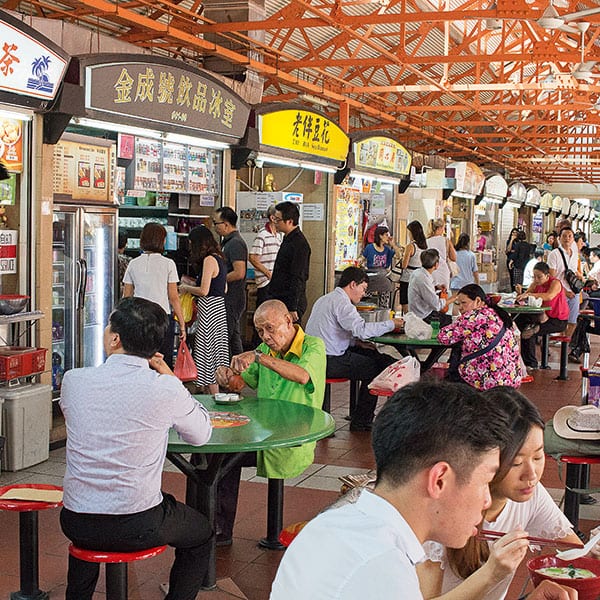
One of my favourite food places in Singapore is Tiong Bahru Market (30 Seng Poh Road) in a picturesque, low-rise neighbourhood that’s undergoing regeneration. The food market has beautifully arranged piles of tropical fruit – mangosteens, rambutans, papayas – bunches of colourful orchids and counters of fresh meat and fish.

The upstairs hawker centre is a relaxed place popular with locals, from schoolchildren in uniforms to pensioners, who sit at communal Formica-topped tables. Part of the fun is walking around, checking out the menus and deciding what to eat – an enjoyable exercise in hungry anticipation. I ignored the steamed buns (pau) and headed to my favourite shui kueh stall for freshly cooked, moist rice cakes topped with pickled vegetables and a dollop of chilli sambal.
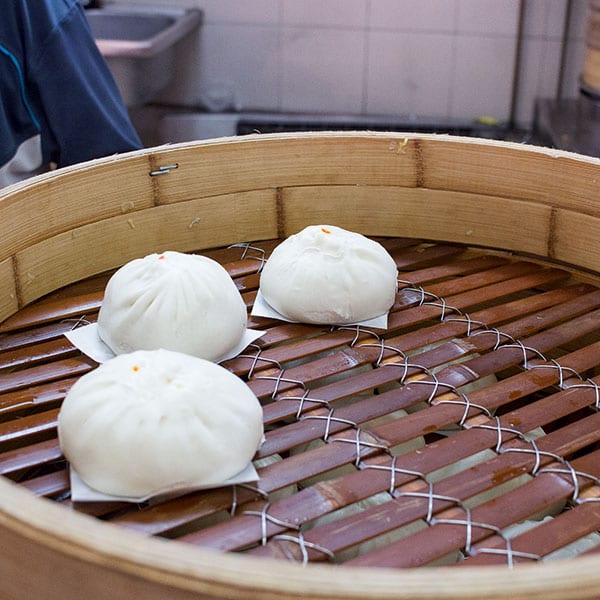
From another stall, I ordered freshly squeezed sugar cane juice, a childhood favourite. Just as I did all those years ago, I enjoyed watching the canes being pressed in a mangle-like contraption and the grassy sweetness of the resulting green juice. A handy hint for hawker centre eating: bring tissues for wiping your hands, as the locals do.
The must-taste list
There are certain, special dishes that a food-loving visitor mustn’t miss. For a typical breakfast, my family and I headed to the original Killiney Kopitiam (67 Killiney Road), a small, white-tiled coffee shop, so popular it now has numerous branches in Singapore and around the world.
We got our day off to a good start with kopi (coffee made with condensed milk), their famous kaya toast – two pieces of charcoal-grilled toast sandwiched with kaya (pandan-flavoured egg and coconut curd) and a chunk of butter – and chee cheong fun (rice pasta rolls with sweet sauce and sambal).
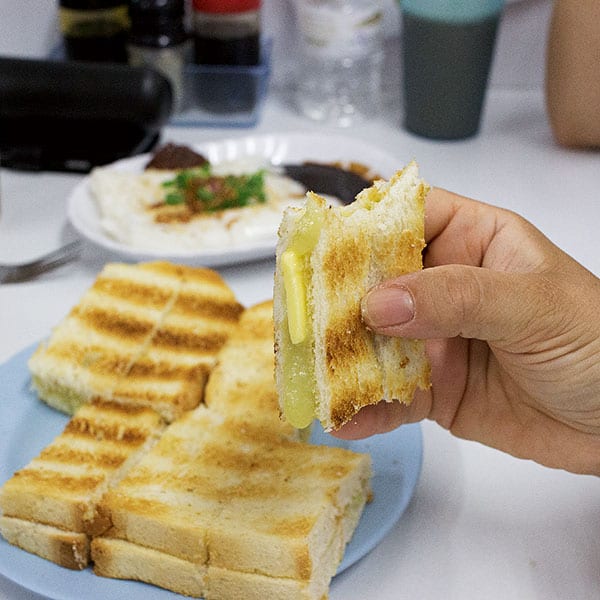
For lunch, Hainanese chicken rice is a classic. When well made this simple combination of lightly poached chicken, stock-cooked rice, light broth and dipping sauces is Singaporean comfort food at its best.

The Tian Tian stall at Maxwell Road Centre is noted for this dish; American chef Anthony Bourdain is a big fan so prepare to queue patiently. A more leisurely chicken rice experience is found at YY Kafei Dian (37 Beach Road) a pleasantly old-fashioned, open-sided Chinese restaurant where we sat at small marble-topped tables marvelling at the chef’s cleaver skills.
My cousins had the insider intel on a finger-lickingly good place for chilli crab, another Singapore classic. We went inland to Chin Huat Live Seafood Restaurant (Block 105 Clementi St 12, 1-30), a family-run establishment hidden away on the ground level of a block of public housing flats. We chose from tanks of live seafood and tucked in, mopping up the piquant chilli sauce with fluffy mantou buns.

Fish head curry is also a national dish, giving a classic Chinese ingredient an Indian flavour. Eat it off banana leaves at Banana Leaf Apolo (54 Race Course Road) in Little India or head, as I did, to leafy Dempsey Hill and Samy’s Curry (Block 25, Dempsey Road), where the fish is delivered fresh daily and the curry is beautifully spiced.
Travelling to different parts of Singapore to try the best version of a particular dish is part of the fun of visiting the city. Laksa is a spicy seafood noodle coconut milk soup – another classic dish with lots of variations. I made my way east to the characterful Katong neighbourhood to visit local institution 328 Katong Laksa (216 East Coast Road) and slurped up a bowlful at a small outdoor table.
Singapore’s ‘fusion’ food
A visit to Singapore also gives me a rare chance to sample Nonya cuisine, the food of the Peranakans or Straits Chinese. Wealthy Peranakans settled in Katong in the 1920s, giving the area its special identity, and some of the traditional pastel-coloured shop-houses remain. Strolling through the → shady walkways, I admired the display of gaudy Nonya kuih (cakes) at Kim Choo Kueh Chang (109/111 East Coast Road) and browsed the tableware next door.
For a refined taste of this cuisine, I went to National Kitchen (1 St Andrew’s Road), a restaurant set up by acclaimed Nonya food writer Violet Oon. Housed in Singapore’s National Gallery, overlooking the open green space of the historic Padang, this is an elegant establishment, complete with dark wood, mirrors and chandeliers. We feasted on classic Nonya dishes, including ayam buah keluak, made from chicken cooked with distinctive, bitter-tasting, soft-textured fermented black nuts.
Nonya dishes combine Chinese and Malay culinary traditions to great effect and are noted within Singapore and Malaysia for their intricate spicing and involved techniques. It seems apt in this rich melting pot of a country to find complex fusion food showcased in its historic heart. Singapore’s rich food heritage continues to surprise and delight, rooting this city of skyscrapers firmly into its past.
Jenny’s latest cookbook is Garlic (Ryland, Peters, Small)
Subscribe to our magazine
Food stories, skills and tested recipes, straight to your door... Enjoy 5 issues for just £5 with our special introductory offer.
Subscribe
Unleash your inner chef
Looking for inspiration? Receive the latest recipes with our newsletter
